Philips Fidelio Android dock or phone audio system
Today, I got into the hands of an older model from the line of docking stations for Philips Fidelio Android phones. The model is called AS851.
Characteristics:
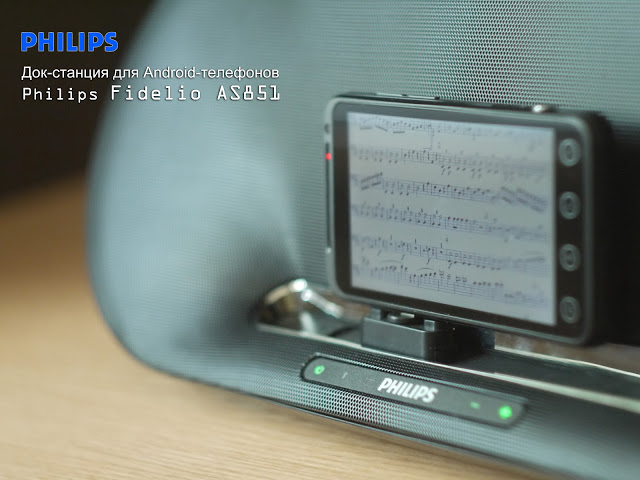
Review:
1) Reflects only the opinion of the author, and nothing more. If you think this is PR, then continue.
2) Maybe it certainly contains spelling, punctuation, grammar and other types of errors, including semantic. The author will be grateful for the information about them (of course, in private, and even better with the help of this wonderful extension ), but does not guarantee their elimination.
Cost:
According to the Yandex market, the prices for this docking station vary: from 6800 to 8000, or even 9500 in a company store)).
Cost: 5 points out of 10
In my opinion, a little expensive. Although the analogs (audio systems of comparable power capable of receiving a signal via BT) - Mobidick SuperTooth Disco, JBL On Beat Xtreme cost about the same.
Packaging and equipment
Packed in a compact box, the size of a little more than the dock itself. Internal coasters are made of recycled paper, which negatively affected convenience - having pulled out, for 10 minutes I blew paper dust from all openings of the station, power supply and remote control.
Unfortunately, the box spoiled PonyExpress, pasted it almost completely with branded adhesive tape, so there will be no photos of the box. Let's move right to the subject of the review: Power supply: Powerful, with three and a half amperes and a voltage of 18 volts (not all netbooks have such a power supply ): In addition to the euro plug, BS 1363 is also included in the package : It is indispensable for self-education. For example, you can disassemble it and find a fuse: There was also a control panel in the package - the joy of kinestics.




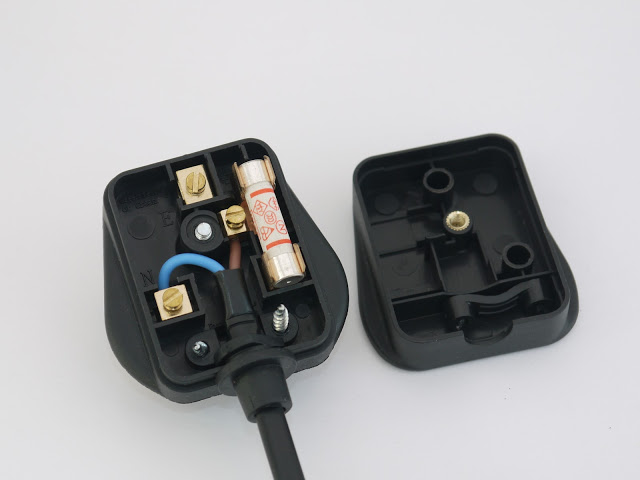
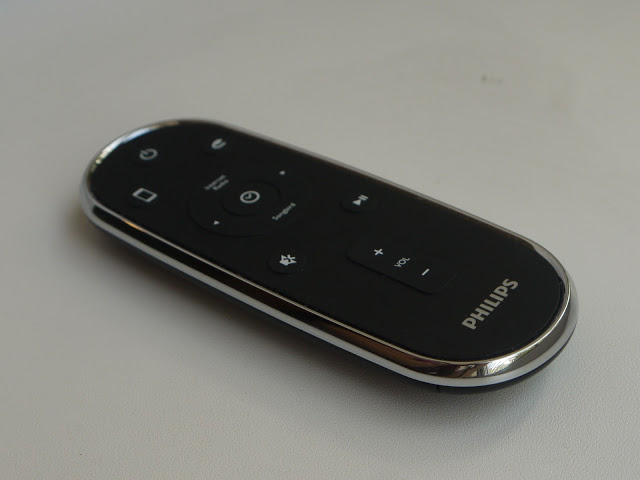
Heavy, comfortable lying in the hand, with convenient buttons. I don’t see much sense in it, but the first two days I kept spinning it in my hands, occasionally pressing a couple of buttons: And a jack3.5-jack3.5 cable to connect all the rest of the equipment that does not have BT. Packaging and packaging for: 6 points out of 10 Remote control is good.
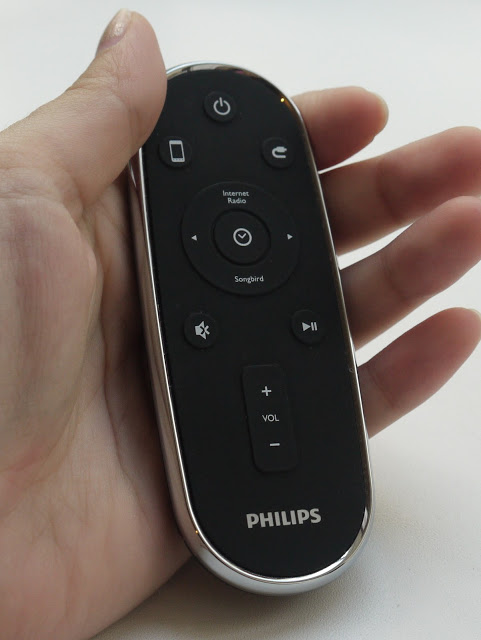
Appearance
After shaking off paper dust and peeling off the stickers:
We see this:
The inscriptions on the ass probably describe our time most accurately:
Designed in the Netherlands, made in China.
Reverse:
My knee lit up in the reflection.
There are two openings of the phase inverters at the back:
Power connector, audio input, USB output (power only):
Special attention should be paid to Philips' pride - the universal FlexiDock connector that fits most phones.
The MicroUSB plug itself can rotate 360 degrees, the wheels on the sides adjust the racks on which the phone rises, and this whole design goes back and forth and sways!
On the front panel there are three buttons - power, volume (+) and volume (-):

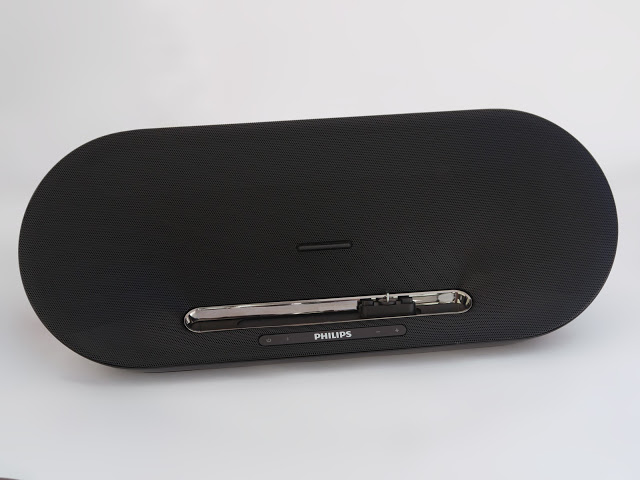
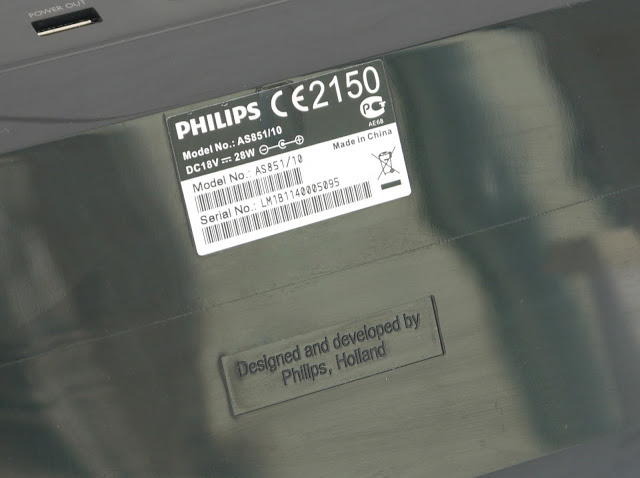


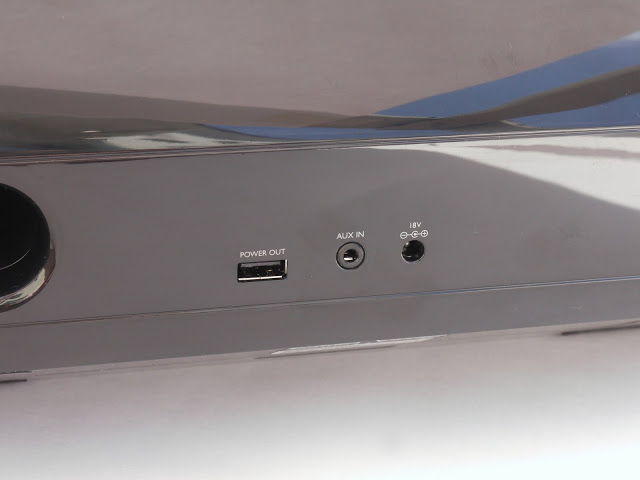
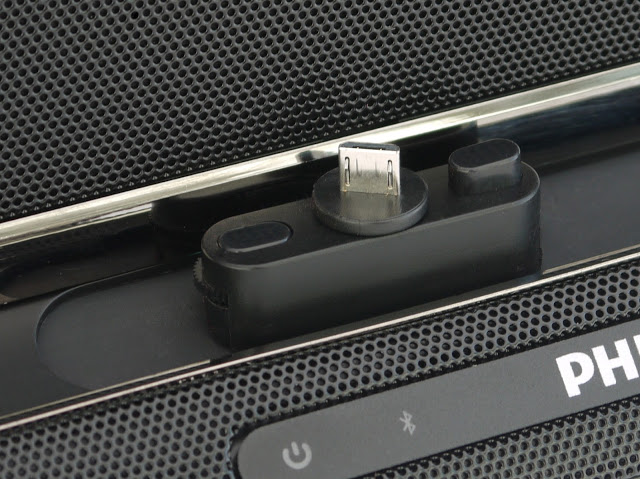

Appearance on: 8 points out of 10
Insides, khaki, fashion and maintainability
The first question is how to disassemble? No holes, no screws either. The only thing the eye clung to was a sticker on the bottom and rubber legs in the same place. Tear off the sticker. Nothing. We tear off the legs. Yeah! 8 screws. We turn off, but nothing happens.
Well, let's go on the other side. We remove the lattice covering the speakers: The first point of soldering to be soldered (or torn off, then soldered anyway) - the earth wire will interfere with you during the next disassembly operation. The cable from the connector is pulled out in the direction of the arrow: Unscrew 9 screws (marked in red). By the way, the IR-receiver of the remote control and the connectors for programming are marked in blue: Two more screws (red). You can not even touch the green ones - they fix the platform with the plug: Evaluate the design of the moving plug - the "treadmill":
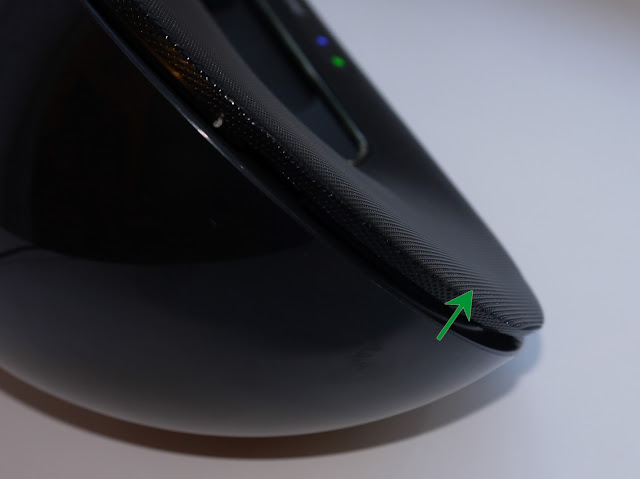
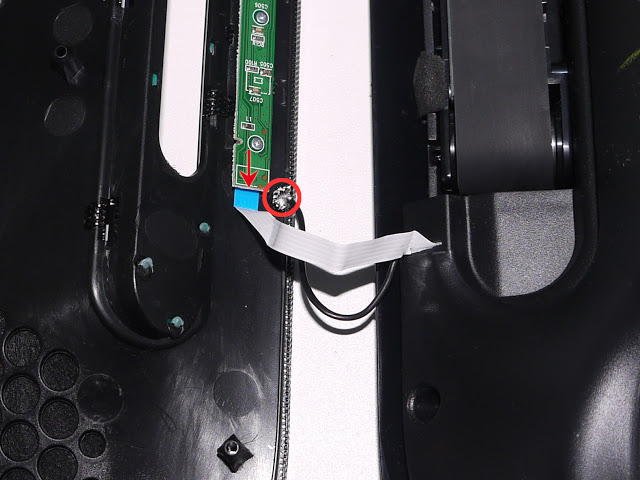

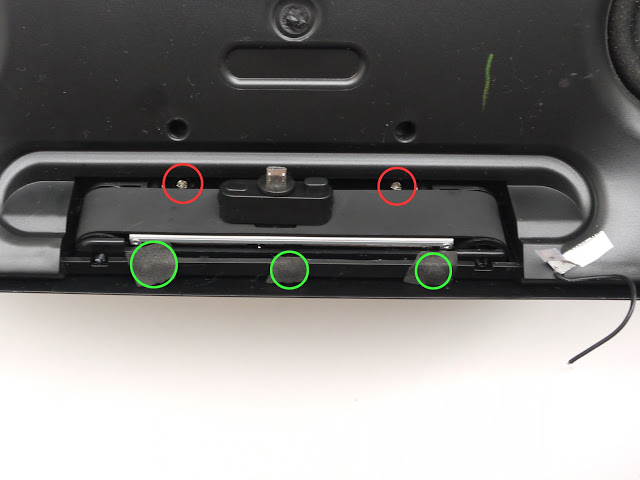
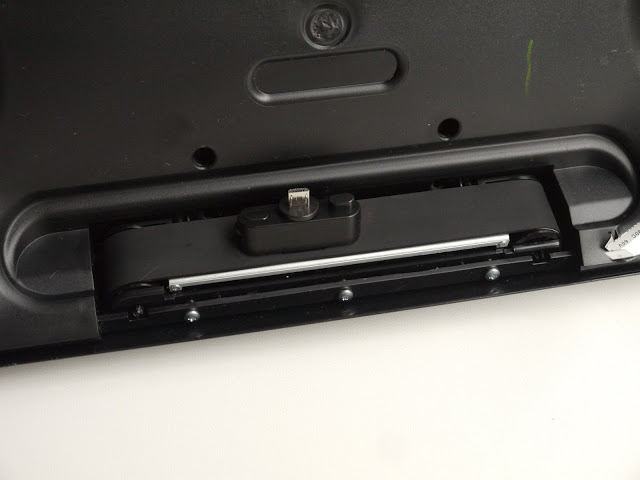
Carefully remove the front cover, disconnect 7 connectors, and another soldering point (red): All joints are glued with adhesive tape for sealing: Two 8-ohm speakers of 15W each: The board is attached with 5 screws (you can not unscrew the green one): On the one hand: C another: Traditional photo: Separate BT-module: Rear (bass reflex tubes and a little syntepon as a damper): Yes, the elastic bands on the bottom could not be torn off - they fastened weighting materials (which are also glued), and did not affect disassembly columns. Everything is going, by itself, in the reverse order. Internals at: 8 points out of 10



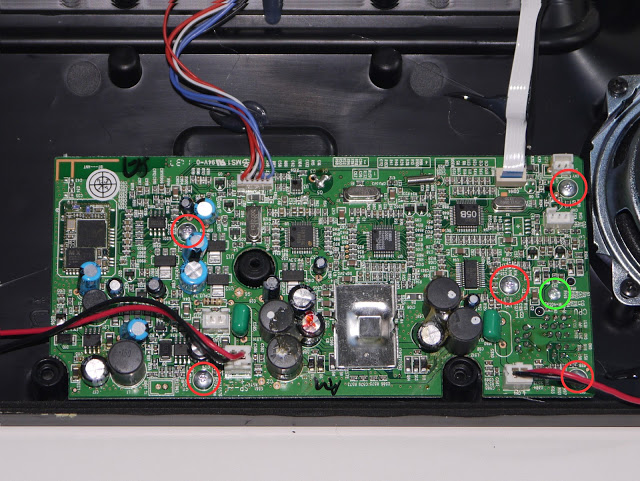





Although I recalled a couple of times with the kind word of Philips engineers when I was disassembling the docking station, I must admit that everything was neatly and reliably assembled. Compared to China, there are a lot more screw connections.
Characteristics, sound
As the offsite aptly observes, “Fine tuned bass channels for reproducing deep, dense bass.” Bass is the first thing that catches your eye when listening to the system. Although, a friend who came to the light even liked it - “so small, but how it shakes,” he appreciated, turning the volume to maximum. Okay, there is no problem with that - which player does not have an eucalyzer, we slightly lower the low frequencies, and you can listen without distracting the boom-boom and battery knocks from the neighbors.
The sound quality is at a height that is ensured by the full support of the A2DP - BT profile, which allows transmitting the audio stream in the form of the source file, and decode and process it on the “capacities” of the client, that is, in this case, the docking station. Due to the DAC and amplifier of a higher class than in the phone itself - the sound quality will be better than when connected via cable.
Of course, from two speakers at such a short distance it is impossible to achieve a volumetric sound - at a distance of a couple of meters you will hear both channels without any separation. But in this case, such a task was not posed, it is a docking station, not studio speakers.
The sound is clear, without wheezing at any volume level. The power reserve is very large - at half volume, the system allows you to hear music with acceptable detail throughout the apartment, and at maximum speed it can voice a small party.
When turned on, the volume rises smoothly, which is very convenient and pleasant when listening to music, but sometimes it causes discomfort when watching movies - the beginning of the phrase is cut off.
Characteristics on: 8 points out of 10
Just a good sound, but in my opinion, went too far with the bass. It is treated with an eucalyzer.
BY
The sticker on the station talks about the Android application, whose calling is to increase the convenience when working with it.
As I understood from the offsite, the application from version 25 is no longer called Fidelio, but DockStudio. However, neither one nor the other refused to download on my 5 Chinese phones, after which I had to ask for help from the audience.
For the same sufferers, like me, I post these programs: download Philips Fidelio , Philips DockStudio
The application does not know anything special, it starts automatically when the phone is installed on the dock, it can show the clock, play Internet radio, or work as an alarm clock. Two interesting functions are the ability to edit the preset of the eucalyzer of the dock itself (they are saved), and updating the firmware. I did not notice the difference after the update, but it certainly is.
An interesting mechanism for pairing the station and the phone. There is no PIN code, after the request, the station cancels the pairing and “calls back” itself, requesting authorization without a code.
I really did not like the fact that the station turns off after about 10 minutes of inactivity. She's plugged in, why turn it off? Due to fear that a cunning neighbor might connect to her with her phone and lose her wake-up call at 4 in the morning? so for this you need a pin code :)
ON: 5 points out of 10
Works. Here are more settings ...
Summary:
Philips has created a very interesting niche product, which (unlike AS351 and AS111) I would rather call an audio system for the phone than a docking station.
In the next issue: You can see all the photos from the review in original resolution in the Picasa album . There you can ask a question or leave a comment. And you can subscribe so as not to miss new reviews on the company page and in my profile (the “subscribe” button)
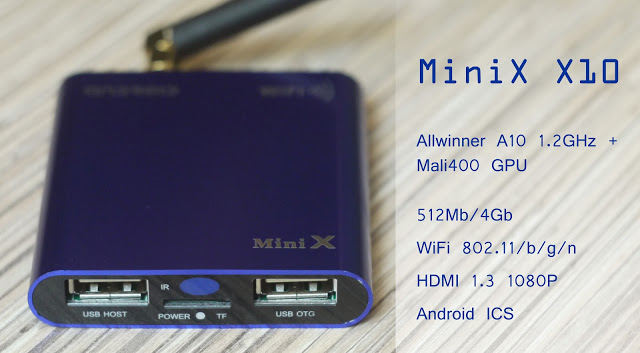

- Power: 2x15 W
- Bluetooth profiles: A2DP, AVRCP, SPP
- FlexiDock, suitable for any phone with MicroUSB
- Remote control
- Dimensions: 140 * 157 * 421 mm
Review:
1) Reflects only the opinion of the author, and nothing more. If you think this is PR, then continue.
2) Maybe it certainly contains spelling, punctuation, grammar and other types of errors, including semantic. The author will be grateful for the information about them (of course, in private, and even better with the help of this wonderful extension ), but does not guarantee their elimination.
Cost:
According to the Yandex market, the prices for this docking station vary: from 6800 to 8000, or even 9500 in a company store)). Cost: 5 points out of 10
In my opinion, a little expensive. Although the analogs (audio systems of comparable power capable of receiving a signal via BT) - Mobidick SuperTooth Disco, JBL On Beat Xtreme cost about the same.
Packaging and equipment
Packed in a compact box, the size of a little more than the dock itself. Internal coasters are made of recycled paper, which negatively affected convenience - having pulled out, for 10 minutes I blew paper dust from all openings of the station, power supply and remote control. Unfortunately, the box spoiled PonyExpress, pasted it almost completely with branded adhesive tape, so there will be no photos of the box. Let's move right to the subject of the review: Power supply: Powerful, with three and a half amperes and a voltage of 18 volts (not all netbooks have such a power supply ): In addition to the euro plug, BS 1363 is also included in the package : It is indispensable for self-education. For example, you can disassemble it and find a fuse: There was also a control panel in the package - the joy of kinestics.






Heavy, comfortable lying in the hand, with convenient buttons. I don’t see much sense in it, but the first two days I kept spinning it in my hands, occasionally pressing a couple of buttons: And a jack3.5-jack3.5 cable to connect all the rest of the equipment that does not have BT. Packaging and packaging for: 6 points out of 10 Remote control is good.

Appearance
After shaking off paper dust and peeling off the stickers:
We see this:
The inscriptions on the ass probably describe our time most accurately:
Designed in the Netherlands, made in China.
Reverse:
My knee lit up in the reflection.
There are two openings of the phase inverters at the back:
Power connector, audio input, USB output (power only):
Special attention should be paid to Philips' pride - the universal FlexiDock connector that fits most phones.
The MicroUSB plug itself can rotate 360 degrees, the wheels on the sides adjust the racks on which the phone rises, and this whole design goes back and forth and sways!
On the front panel there are three buttons - power, volume (+) and volume (-):







Appearance on: 8 points out of 10
Insides, khaki, fashion and maintainability
The first question is how to disassemble? No holes, no screws either. The only thing the eye clung to was a sticker on the bottom and rubber legs in the same place. Tear off the sticker. Nothing. We tear off the legs. Yeah! 8 screws. We turn off, but nothing happens. Well, let's go on the other side. We remove the lattice covering the speakers: The first point of soldering to be soldered (or torn off, then soldered anyway) - the earth wire will interfere with you during the next disassembly operation. The cable from the connector is pulled out in the direction of the arrow: Unscrew 9 screws (marked in red). By the way, the IR-receiver of the remote control and the connectors for programming are marked in blue: Two more screws (red). You can not even touch the green ones - they fix the platform with the plug: Evaluate the design of the moving plug - the "treadmill":





Carefully remove the front cover, disconnect 7 connectors, and another soldering point (red): All joints are glued with adhesive tape for sealing: Two 8-ohm speakers of 15W each: The board is attached with 5 screws (you can not unscrew the green one): On the one hand: C another: Traditional photo: Separate BT-module: Rear (bass reflex tubes and a little syntepon as a damper): Yes, the elastic bands on the bottom could not be torn off - they fastened weighting materials (which are also glued), and did not affect disassembly columns. Everything is going, by itself, in the reverse order. Internals at: 8 points out of 10









Although I recalled a couple of times with the kind word of Philips engineers when I was disassembling the docking station, I must admit that everything was neatly and reliably assembled. Compared to China, there are a lot more screw connections.
Characteristics, sound
As the offsite aptly observes, “Fine tuned bass channels for reproducing deep, dense bass.” Bass is the first thing that catches The sound quality is at a height that is ensured by the full support of the A2DP - BT profile, which allows transmitting the audio stream in the form of the source file, and decode and process it on the “capacities” of the client, that is, in this case, the docking station. Due to the DAC and amplifier of a higher class than in the phone itself - the sound quality will be better than when connected via cable.
Of course, from two speakers at such a short distance it is impossible to achieve a volumetric sound - at a distance of a couple of meters you will hear both channels without any separation. But in this case, such a task was not posed, it is a docking station, not studio speakers.
The sound is clear, without wheezing at any volume level. The power reserve is very large - at half volume, the system allows you to hear music with acceptable detail throughout the apartment, and at maximum speed it can voice a small party.
When turned on, the volume rises smoothly, which is very convenient and pleasant when listening to music, but sometimes it causes discomfort when watching movies - the beginning of the phrase is cut off.
Characteristics on: 8 points out of 10
Just a good sound, but in my opinion, went too far with the bass. It is treated with an eucalyzer.
BY
The sticker on the station talks about the Android application, whose calling is to increase the convenience when working with it. As I understood from the offsite, the application from version 25 is no longer called Fidelio, but DockStudio. However, neither one nor the other refused to download on my 5 Chinese phones, after which I had to ask for help from the audience.
For the same sufferers, like me, I post these programs: download Philips Fidelio , Philips DockStudio
The application does not know anything special, it starts automatically when the phone is installed on the dock, it can show the clock, play Internet radio, or work as an alarm clock. Two interesting functions are the ability to edit the preset of the eucalyzer of the dock itself (they are saved), and updating the firmware. I did not notice the difference after the update, but it certainly is.
An interesting mechanism for pairing the station and the phone. There is no PIN code, after the request, the station cancels the pairing and “calls back” itself, requesting authorization without a code.
I really did not like the fact that the station turns off after about 10 minutes of inactivity. She's plugged in, why turn it off? Due to fear that a cunning neighbor might connect to her with her phone and lose her wake-up call at 4 in the morning? so for this you need a pin code :)
ON: 5 points out of 10
Works. Here are more settings ...
Summary:
Philips has created a very interesting niche product, which (unlike AS351 and AS111) I would rather call an audio system for the phone than a docking station. In the next issue: You can see all the photos from the review in original resolution in the Picasa album . There you can ask a question or leave a comment. And you can subscribe so as not to miss new reviews on the company page and in my profile (the “subscribe” button)

